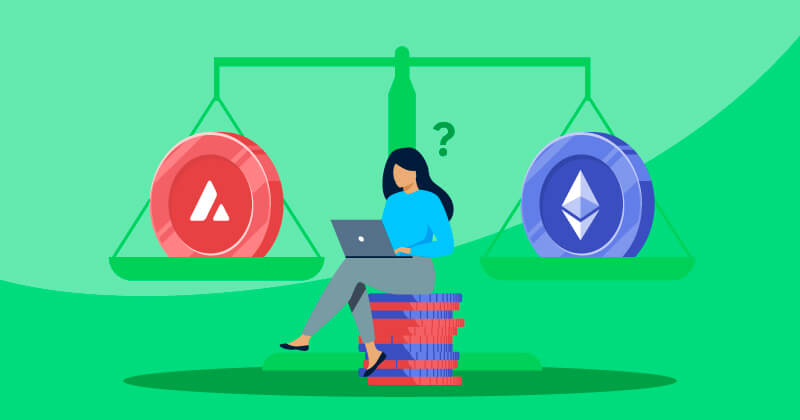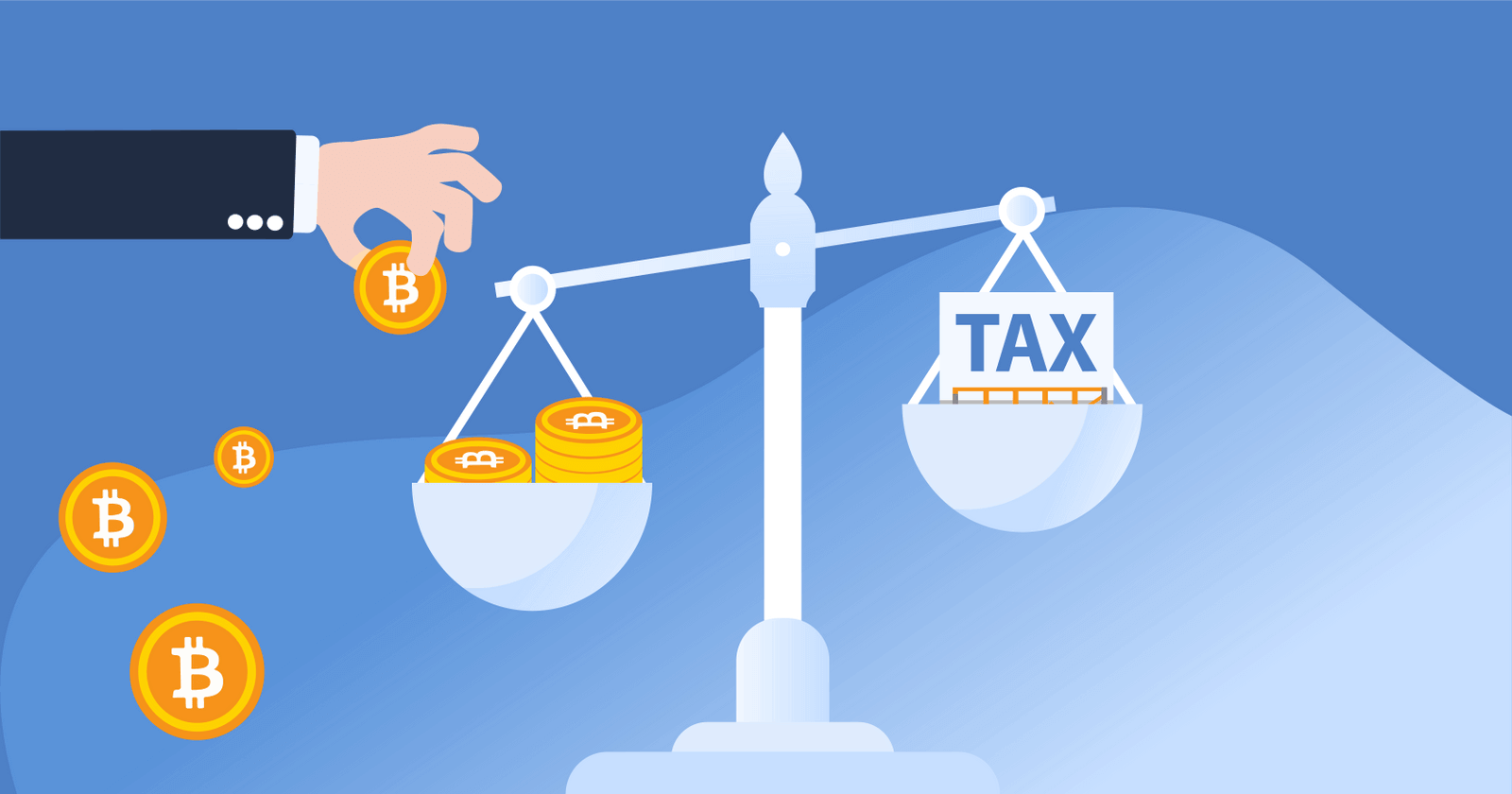

Ethereum vs. Avalanche — which will be the best smart contract blockchain on the market?
In this guide, we’ll break down everything you need to know about Ethereum and Avalanche, including how both blockchains work, the pros and cons of each network, and which blockchain is the best option in 2025.

Disclaimer: This article is not intended to be investment advice. Please do your own research, and talk to your financial advisor before buying and selling cryptocurrencies.
What is Ethereum?
Ethereum was created back in 2014. It was famous for being the first blockchain network that was created to support smart contracts — the building blocks for decentralized applications, NFTs, and DeFi protocols.
Today, most decentralized applications are built on Ethereum. If you’re trading crypto on Uniswap or buying NFTs on OpenSea, you’re most likely using the Ethereum network!
Ethereum uses Ether (ETH) as its utility token to reward transaction validators and pay blockchain network fees. Today, ETH is one of the most popular and most well-known cryptocurrencies in the world.
How does Ethereum work?
In the past, Ethereum has faced criticism for high fees and slow transaction times. However, the network has made changes in recent years to upgrade scalability.
- In 2022, Ethereum’s consensus mechanism switched from Proof of Work (PoW) to Proof of Stake (PoS). This means drastically lower energy consumption and more scalability.
- It’s estimated that when the upgrade to Ethereum 2.0 is fully implemented, Ethereum will be able to handle up to 100,000 transactions per second! However, the full upgrade will likely take several years to complete.
- Starting in 2021, Ethereum has become a deflationary asset. Base transaction fees are burned — meaning that the supply of ETH will likely fall over time.
What is Avalanche?
Avalanche was launched in 2020 — at a time when Ethereum was plagued with complaints about high fees and slow transaction times. Avalanche claimed that its unique consensus mechanism would offer fast transactions and high security.
How does Avalanche work?
Avalanche’s architecture contains advantages that may help the network with scalability and fast transaction times.
- Avalanche’s Snow consensus mechanism allows a small percentage of nodes to confirm blockchain transactions — which means that the system is more efficient than traditional PoS consensus mechanisms.
- Avalanche uses three separate blockchains to make sure the network is fast and scalable — the X-chain, C-chain, and P-chain!
- Avalanche’s total cryptocurrency supply is capped at 720 million AVAX! The supply of AVAX is controlled by holders, who can determine staking rewards.
What is the C-chain, X-chain, and P-chain on Avalanche?
Let’s take a closer look at how each one of the Avalanche sub-chains functions!
C-chain: The C-chain is used to support Ethereum-compatible DeFi applications, NFTs, and smart contracts. Currently, the vast majority of activity taking place on the Avalanche network takes place on the C-chain.
X-chain: The X-chain is used to send and receive Avalanche-based assets. Unlike the C-chain, this chain is not EVM-compatible and can only be used with Avalanche wallets.
P-chain: The P-chain is used to handle the Avalanche consensus mechanism. The P-chain is also used to give out staking rewards and allow developers to build ‘subnets’ on Avalanche.
Is Avalanche compatible with Ethereum?
Avalanche’s C-chain is EVM-compatible, meaning that you can transfer Ethereum-based assets. You can transfer tokens and NFTs between Ethereum and Avalanche using the Avalanche Bridge.
What’s better: Ethereum or Avalanche?

While Avalanche may have technical advantages over Ethereum, Ethereum still is by far the largest and most popular blockchain for smart contracts!
Ethereum benefits from a first-mover advantage. Because Ethereum was the first blockchain for smart contracts, it provides the building blocks for most popular NFTs and DeFi applications today!
Ethereum vs Avalanche: Adoption
Winner: Ethereum
Next to Bitcoin, Ethereum is one of the most popular and well-known cryptocurrencies in the world! Today, some of the world’s most popular decentralized applications are built on the Ethereum network. As of September 2023, Ethereum supports more than 1 million transactions per day.
While Avalanche is by no means an unknown blockchain, its popularity still lags behind Ethereum. As of September 2023, Avalanche supports more than 150,000 transactions per day.
Ethereum vs Avalanche: Speed
Winner: Avalanche
According to company data, Avalanche can handle up to 6,500 transactions per second.
Currently, the Ethereum network handles around 15 transactions per second. It's estimated that Ethereum will be able to handle around 100,000 transactions per second after all Ethereum 2.0 upgrades are completed. Still, it’s likely that these upgrades are years away from implementation.
Ethereum vs Avalanche: Fees
Winner: Avalanche
Avalanche is a great option when it comes to low transaction fees.
It’s estimated that the average transaction fee for a transaction Avalanche is $0.08. Meanwhile, the average transaction for a transaction on Ethereum is typically around $1.50.
Ethereum vs Avalanche: Tokens
Winner: Ethereum
Ethereum and Avalanche both have utility tokens — ETH and AVAX.
ETH is one of the most well-known cryptocurrencies in the world and is available on almost all major exchanges. Today, ETH has a market cap over $190 billion. ETH can be used to buy popular NFTs on sites like OpenSea and get started with popular DeFi applications.
AVAX is a popular cryptocurrency — but is not available on many major exchanges. AVAX has a market cap of just over $6 billion.
Still, it’s important to note that smaller cryptocurrencies like AVAX may have higher growth potential than their more-established competitors.
Ethereum vs Avalanche: DeFi
Winner: Ethereum
Ethereum has the most developed DeFi ecosystem compared to any other blockchain. Some of the most popular DeFi applications are built on Ethereum — like Uniswap, Compound, and Aave. Whether you’re looking to lend, borrow, stake, or yield farm — you’ll be able to find a DeFi application on Ethereum that will support your needs!
While Avalanche offers the same DeFi functionality, Avalanche’s DeFi ecosystem is not as developed as Ethereum’s and has not reached the same level of adoption.
Ethereum vs. Avalanche: NFTs
Winner: Ethereum
Currently, Ethereum is the #1 blockchain when it comes to NFT trading volume.
Because Ethereum is well-established and has a large existing user base, popular NFT collections and games are typically launched on Ethereum — such as Bored Ape Yacht Club and Axie Infinity!
It’s possible that in the future, Avalanche will be a superior option for NFTs. Some argue that Avalanche’s scalability advantages make the blockchain a better fit for NFT games. In addition, popular NFT marketplaces like OpenSea have begun to support the Avalanche blockchain.
Ethereum vs. Avalanche: Decentralization
Winner: Ethereum
Decentralization is one of the core tenets of the cryptocurrency ecosystem. Cryptocurrency enthusiasts often believe that blockchain networks should not be controlled by any one person or group of people — but instead, should be owned by the community.
To better understand how decentralized Ethereum and Avalanche are, we can take a look at how many validators each blockchain has.
As of the time of writing, Ethereum has more than 900,000 node operators. Meanwhile, Avalanche has just over 1,300 node operators.
Can Avalanche surpass Ethereum?

Currently, Ethereum is one of the biggest cryptocurrencies in the world — right below Bitcoin. At the time of writing, Ethereum’s market capitalization is more than $190 billion. Meanwhile, Avalanche’s market capitalization is just above $6 billion.
In recent years, many blockchains have claimed to be the ‘Ethereum killer’ — including Avalanche, Solana, Cardano, and more! However, none of these blockchains have reached the same level of usage and adoption as Ethereum.
Currently, Ethereum has the most users of any smart contract blockchain and most popular decentralized applications and NFTs are built on Ethereum. This means that it will be difficult for any competitor to surpass Ethereum in the future.
How to buy Ethereum and Avalanche
The easiest way to buy cryptocurrencies like Ether and Avalanche is to sign up for an account on a centralized exchange. Here are a few trusted cryptocurrency exchanges that allow you to trade ETH and AVAX!
Coinbase: Coinbase is one of the biggest names in the cryptocurrency market! Coinbase is known for its easy-to-use platform and its beginner-friendly features!
Gemini: Gemini is one of the few cryptocurrency exchanges available in all 50 states! The exchange has a reputation for security and working closely with regulators.
Kraken: Kraken, founded in 2011, is one of the oldest cryptocurrency exchanges on the market. The exchange is known for offering some of the lowest transaction fees in the industry!
Frequently asked questions
- What is AVAX?
AVAX is the Avalanche blockchain’s utility token. AVAX is used to pay network fees and reward stakers who help to validate transactions.
- Is Avalanche better than Ethereum?
While Avalanche offers faster transaction times and lower fees, Ethereum is still by far the biggest blockchain network for deploying smart contracts.
- Is Avalanche the same as Ethereum?
While Avalanche and Ethereum both offer features like smart contracts, DeFi, and NFTs, the two blockchain networks have key differences — such as network architecture!
- Is Avalanche the next Ethereum?
Ethereum is one of the biggest blockchains in the world. While Avalanche is a legitimate competitor, it’s difficult to tell whether it will replace Ethereum as the world’s biggest smart contract blockchain.
How we reviewed this article
All CoinLedger articles go through a rigorous review process before publication. Learn more about the CoinLedger Editorial Process.

CoinLedger has strict sourcing guidelines for our content. Our content is based on direct interviews with tax experts, guidance from tax agencies, and articles from reputable news outlets.




























%20(1).png)





.png)
















